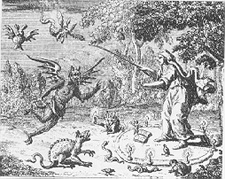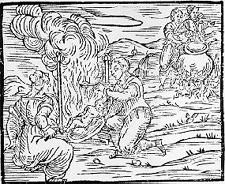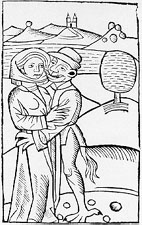
--from R. Boulton, _History of Magic_, 1715-16.
 |
--from R. Boulton, _History of Magic_, 1715-16. |
It was not until the very end of the medieval period (ca. 1500) that a definition emerged of the witch as a person in league with the devil, and that full-scale persecution began. In the period from 1000-1500 concepts of the witch ranged from that of benevolent healer to feared sorcerer or sorceress. The transition from these early vague ideas of witchcraft to a fully-formed image of the diabolical witch deserves study in the history of marginality because it illustrates the rhetoric of persecution that had come into existence by the end of the medieval period. In fact, the languages of exclusion aimed at deviant sexuality, heretics, Jews, and lepers, were all utilized in the definition of the witch.
Both men and women were accused of witchcraft. Even the notorious witch-hunting manual, the Malleus Malleficarum, used pronouns of both genders to discuss and to identify witches. On the other hand, the Malleus also contained statements like "No one does more harm to the Catholic faith than midwives". Furthermore, estimates indicate that, in the period of greatest persecution (1500-1700) the overwhelming majority of executed victims were female (82%).
The origins of medieval witchcraft are not clear. Jeffrey Russell identified four current theories about medieval witchcraft:
To these four theories should be added a fifth, elucidated by Anne Barstow:
Alan Kors and Edward Peters note that in order for witch persecution to occur on a large scale in Europe, four critical elements were necessary:
--A detailed Christian cosmography which was a common frame of reference throughout Europe (not present before 1100)
--A systematic ontology in which demons and witches had a logically consistent place (not present before 1200)
--A permanent body of investigators and judges empowered to discover and uproot theological error (not present before 1300)
--A public subjected to centralized and consistent laws and vulnerable to widespread social strain as well as terror (not present before 1400)
It is clear that the rhetoric of persecution used against the other marginal groups in our study were all heaped upon the figure of the witch. These include:
 |
--from F. Guazzo, _Compendium Maleficarum_, 1608. |
Documents
Papal Bull of 1484, Extracts from the Malleus Malleficarum, Johannes Nider on Witches
Extracts from the Malleus Maleficarum ("Hammer of Witches")
Extracts from the trial of Joan of Arc
General Links
 |
--from U. Molitor, _De Lamiis et Phitonicis Mulieribus_, 1490. |
Bibliography
Barstow, Anne Llewellyn. "On Studying Witchcraft as Women's History", Journal of Feminist Studies in Religion, vol. 4 (Fall 1988), 7-19.
Barstow, Anne Llewellyn. Witchcraze. Pandora: San Francisco, 1994.
Douglas, Mary. "Witchcraft and Leprosy", Man,vol. 26 (1991), 723-736
Kieckhefer, Richard. Magic in the Middle Ages. Cambridge University Press: Cambridge, 1989.
Kors, Alan and Peters, Edward. Witchcraft in Europe, 1100-1700: A Documentary History. University of Pennsylvania Press: Philadelphia, 1972.
Russell, Jeffrey Burton. A History of Witchcraft: Sorcerers, Heretics, and Pagans. Thames and Hudson:1983
Strayer, Joseph, ed. Dictionary of the Middle Ages, vol. 12, "Witchcraft", 658-664
"illustrations on this page may not be reproduced without permission of Thames and Hudson Ltd"